The
trike moves forward! This seems counterintuitive to almost everyone
(certainly it is to us), but the result of an experiment with a real trike
is indeed that it moves forward.
You
can check it out - just find a trike. You do have to be careful not to let
that front wheel twist sideways. You need to do something to keep it from
twisting, but without pushing forward or backward on it. You can gently put
a finger against the side of the wheel. Or you could use duct tape (the all-purpose
American solution to all problems) to, say, strap the wheel's fender to the
main frame of the trike. Or you can use a bicycle instead of a tricycle, but
then you have to gently use your fingers to keep it from flopping over sideways.
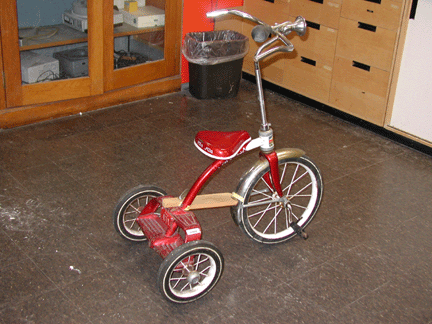
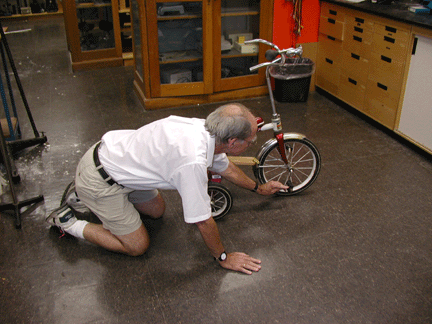
Here's
an analysis of the trike problem, which (if you do it very carefully) is actually
a fairly stiff first-year physics problem. The trike starts at rest, we will
apply a force to the pedal, and we want to know which way it will start
to move. (After it's moved a bit, the pedal will no longer be directly down.
We won't worry about that - just concentrate on its velocity right after it
starts to move.) Forces cause accelerations, and since it starts at
rest, its initial acceleration will be in the same direction as the direction
of its velocity an instant after the beginning of our experiment. So what
we want to know is the direction of its initial acceleration.
The
important parts of the trike are the front wheel and the pedals. You can think
of the rest of the trike as superfluous stuff that is dragged along behind
and keeps the whole trike from tipping over. (If you're planning to use a
bike for your experiment, think about the pedals, the chain, and the rear
wheel, and ignore the rest of the bike.)
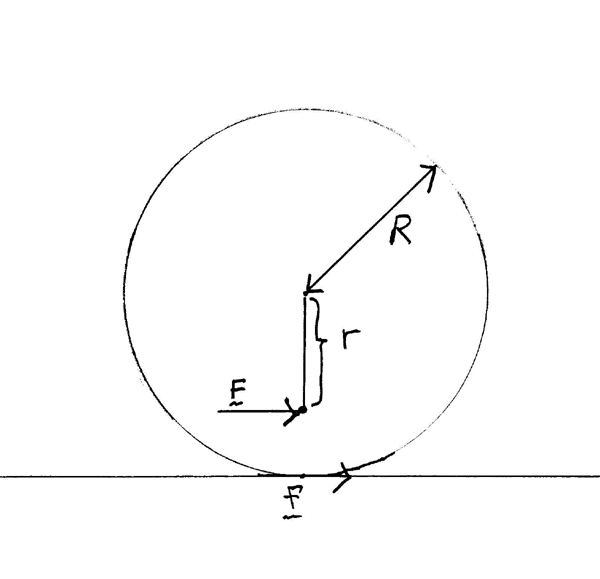
Newton's
second law gives
F
+ f = ma (1)
where
m is the mass and a is the component of the acceleration in the forward
direction. We want a, but f in Eq. (1) is unknown. We need more physics, which
we can get from the torque equation.
As drawn, both F and f produce torques tending to turn the wheel counterclockwise. (That is, counterclockwise around its axle, the center of the wheel. That's what "clockwise" or "counterclockwise" refer to in this discussion. By contrast, in the initial "semi-intuitive" discussion given earlier, that force F tends to turn the wheel clockwise with respect to the contact point with the ground, and f exerts no turning effect at all with respect to that contact point.)
Care
with signs is essential here. Let
a denote the angular acceleration in the clockwise
direction. Then a and a are
related by
a = a/R (2)
and
the torque equation (get the signs right!) is:
Fr
+ fR = - Ia (3)
where
I is the moment of inertia about the center of the wheel.
Now
comes a little algebra (which we'll omit), leading to the results:
a
= FR(R - r)/(I + mR² ) (4)
All
that we care about is the sign of a. Since R > r (the radius of the
wheel is greater than the length of the pedal arm), a is positive - the trike
moves forward.
That
surely is contrary to most people's "intuition", probably because
we have all ridden trikes and we know that the way to back up is to push forward
on the pedal that is pointing down. Remember, though, that in our problem,
we are not sitting on the trike, instead we're standing next to it. Those
are two different situations, and there is no reason to expect their
solutions to be the same.
It's
still strange, though, to see the trike move as it does. As you push forward on
the downward pointing pedal, the trike really does move forward a bit and that
pedal rises up. Here are two sketches of trike-plus-pedal - first when it's at
rest, and then when it has moved a bit.
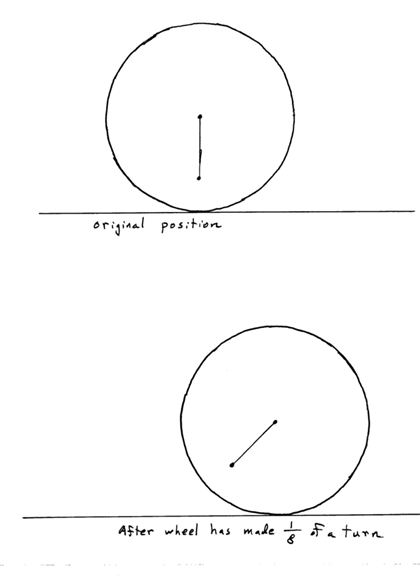
The
wheel as a whole moves forward. So does the pedal. Relative to the wheel,
it's true that the pedal moves backward. That is, though the wheel and pedal
both move forward, the pedal doesn't move quite as far forward as the wheel
does.
You
can also solve equations 1-3 for f, which gives:
f
= - F(I + mRr)/(I + mR²) (5)
Notice
that f is definitely negative. That is, the frictional force always is in
the backward direction. Thus the frictional force, if it acted alone, would
indeed push the trike backward. But in our case, as long as R > r, f
is not large enough to offset the force that we exert, F.
What
if r were greater than or equal to R? That is what if the length of the pedal
arm were as large as the radius of the wheel or even greater? Eq. (4) says that if r = R, then a =0, and
the wheel won't move. And that equation also says that if r > R, then a <
0, that is, that the trike will indeed movebackward.
Normally, you can't have r that large, but you can achieve that condition by putting an extension on the pedal and then resting the whole thing at the edge of a table, so that the “pedal” is down below the edge of the table:
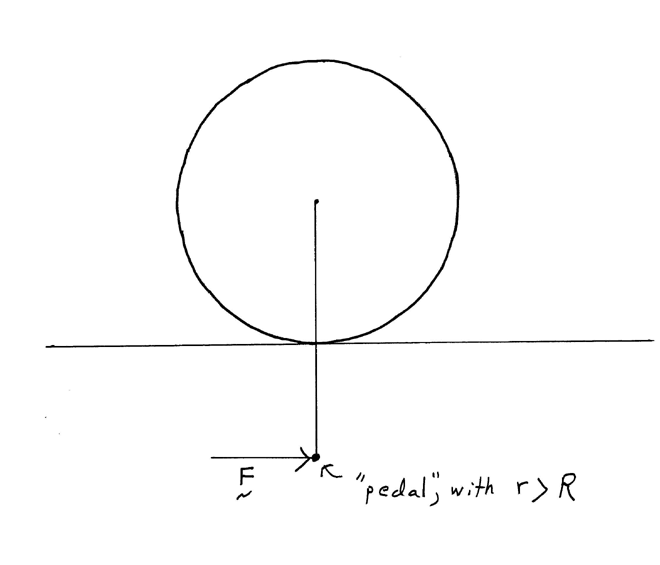
Now
if you push forward just at the edge of the table ( r = R ), you'll find that
the trike won't budge - until you push it so hard that it begins to skid,
without rolling. (We assumed rolling in our analysis of the problem, so our
theory can't be expected to make any sense if
it skids.) And if you apply your forward force down below the edge
of the table (r>R), as in the sketch just above, you'll find that the trike
does begin to move backward.
Alternative Theory:
(This is a careful version of the initial discussion given at the beginning,
what we called the "semi-intuitive" version.) In the preceding analysis,
we calculated torques about the center of mass. It is also legitimate to take
torques about any fixed point, if we're careful, and sometimes it's
simpler to do so. Taking torques about the point in the ground where the wheel
touches the ground, we have:
F(R
- r) = I’a (6)
where
I’ is the moment of inertia with respect to that new point. By the
principal axis theorem (from introductory physics),
I’
= I + mR² ,
and,
with this alternative theory, a is still
equal to a/R.
Putting
those results into Eq. (6) leads to the same expression as before for a, Eq.
(4). This approach is algebraically much simpler. We don't have to introduce
f, since it exerts zero torque about that point in the ground. Although
this approach is simpler and more elegant, it may seem a bit too simple to
be reliable, and it's reassuring to know that we can also get the same result
by our first approach, calculating torques about the center of mass. And part
of the fun of doing physics is that often there are several different and
equally correct ways of tackling the same problem.